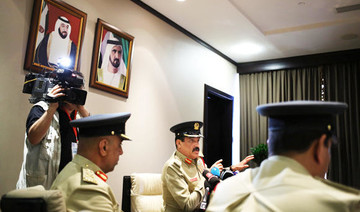DUBAI: Fire broke out in Al-Meer Tower, a 12-story residential building in Dubai’s Barsha Heights, on Wednesday night, causing dozens of terrified families to flee the burning block.
Fire crews reportedly put out the blaze within about 20 minutes but it nevertheless caused substantial damage to parts of the building. There were no reports of any casualties.
Residents of Al-Meer Tower told Arab News that the fire began shortly before 9:00 p.m. Dubai time, causing fear and panic among the families living there as the alarm spread.
Dubai Civil Defense confirmed that it received an alert about the fire at 8:58 p.m. Fire crews and rescue teams from Barsha Brigade reached the site within four minutes, it added. Additional crews and vehicles from Al-Marina Brigade were summoned to provide backup and support. Dubai police cordoned off the scene and rerouted traffic.
Initial on-site investigations suggest that the blaze, officially categorized as a “medium fire,” began on the seventh floor.
The field officer in charge of the operation confirmed that the fire was brought under control within 21 minutes and that the cooling process began at 10:42 p.m.
“No deaths or injuries were recorded,” the officer said, adding that the site has been handed over to the relevant authorities for further investigations into the cause of the fire.
A resident of the building called Jenelle, originally from the Philippines, told Arab News that she and four relatives live in a sixth-floor apartment.
“When the alarm started, we gathered our belongings and went down instantly,” she said. Many of her neighbors were rushing down the stairs and some were panicking and crying, she added.
Elena, from Romania, who lives on the seventh floor, said she jumped up from her bed, where she was eating her dinner, when she was alerted to the fire by her roommate.
“When I went out to the balcony, I told her the fire was in our building as she was seeing a reflection on the opposite building’s glass front,” she said. As they left their apartment, their next door neighbor was shouting “fire,” she added.
A Russian resident said she could see debris falling to the street after she escaped the building and was crossing the road to safety.
A Syrian resident, Tarek, said he was asleep when the fire started. “When I escaped from my flat, rescuers were escorting us to safe zones,” he added.
















